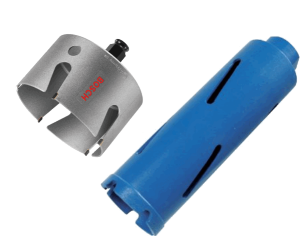Core Drill: Difference between revisions
From DT Online
mNo edit summary |
(Created article) |
||
| Line 14: | Line 14: | ||
Larger and longer '''Core Drills''' are used industrially for mineral exploration. For this purpose, it is the '''core''' of material which the drill removes which is of interest for analysis, rather than the hole it creates. | Larger and longer '''Core Drills''' are used industrially for mineral exploration. For this purpose, it is the '''core''' of material which the drill removes which is of interest for analysis, rather than the hole it creates. | ||
<div class="buyers-guide"> | |||
=====DT Online Buyers' Guide===== | |||
</div> | |||
* <span style="color: red">'''Do not use larger sizes in a drill without a clutch'''.</span> | * <span style="color: red">'''Do not use larger sizes in a drill without a clutch'''.</span> | ||
{| | {| | ||
Revision as of 16:31, 14 May 2016
Description
Core Drills are similar in appearance to Holesaws but they are use principally to make large holes in masonry (e.g. to enable plumbing and other services to pass through the walls of a building).
Features and Uses
The cutting edges are either made of Tungsten Carbide or are Diamond coated. They can be used with a Power Drill.
Safety Point! Their large diameter can result in considerable Torque being transmitted, therefore any Power Drill used must have a clutch that will slip if it grabs. This is to avoid personal injury if the drill is twisted out of the operator's hand
Larger and longer Core Drills are used industrially for mineral exploration. For this purpose, it is the core of material which the drill removes which is of interest for analysis, rather than the hole it creates.
DT Online Buyers' Guide
- Do not use larger sizes in a drill without a clutch.





